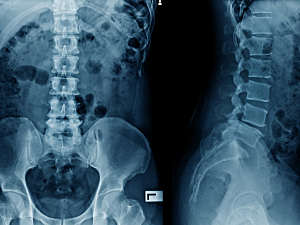Intervertebral disc degeneration (IDD) of the spine is one of the world’s most challenging and pervasive conditions. Commonly available surgical therapies and pharmacological remedies alleviate only a fraction of the pain and discomfort that patients with chronic and worsening back pain suffer daily.
IDD is predominantly due to the progressive loss of special matrix proteins (proteoglycans) that make up the disc, ultimately resulting in clinical diagnoses such as low back pain, sciatica, herniated discs, spinal stenosis and instability.
Brigham and Women’s Hospital is seeking to dramatically shift this picture with a new non-surgical technology and groundbreaking approach to slow down and even possibly prevent disc degeneration. The approach, which promotes disc matrix regeneration, is designed to help patients potentially avoid surgery that is often needed due to the ravages of disc degeneration.
This research is led by James D. Kang, MD, chair of the Brigham’s Department of Orthopaedic Surgery, and his colleague, Shuichi Mizuno, PhD, a Brigham scientist who developed NeoCart®, a revolutionary implant replacement technology for knee cartilage.
“I have long been interested in studying why discs degenerate, the effects of the aging process on the spine and how we can use stem cells and gene therapy to avoid the need for invasive spinal surgery,” Dr. Kang said. “Dr. Mizuno is one of the very few scientists researching how cartilage and intervertebral disc tissue — which is in the family of cartilage tissues — react to various physical and chemical stresses.
“Our collaboration holds the promise of harnessing the regenerative power of the disc’s own cells in order to slow or even stop IDD in its tracks.”
Slowing IDD Through Disc Matrix Regeneration
Through normal movement, spinal discs are constantly exposed to changes in hydrostatic pressure and deviatoric, or shear, stress. Disc degeneration is often associated with the disappearance of the matrix proteins, such as chondroitin sulfate proteoglycan (CSPG) molecule in the nucleus pulposus (NP). These CSPG molecules are involved in important cell processes like cell adhesion and growth, receptor binding and cell migration.
“The spine is a very complicated organ,” Dr. Kang said. “Until now, nobody in the laboratory has studied what these cells do in this tough environment of hydrostatic and osmotic pressures, which mimics what happens in the human body.”
Drs. Kang and Mizuno discovered that when treated with a regimen of pressures intended to mimic daily spinal loading, both bovine (cow) and human NP cells demonstrate an anabolic or regenerative capability. Based on initial results using Dr. Mizuno’s proprietary in vitro spinal motion model, they hypothesized that these cells may further stimulate the regenerative process if matrix proteins such as CSPGs are added as carriers.
“We proved this hypothesis to be true using bovine NP cells, and we expect that human NP cells will react similarly,” Dr. Kang said.
The premise for future clinical treatment, according to Dr. Kang, is to take regenerative NP cells as well as stem cells from the patient’s bone marrow or off-the-shelf inducible stem cells and implant them in the spinal disc. He and Dr. Mizuno are also experimenting with various carriers for the cells, in addition to CSPG, which may protect cells from changes in osmotic pressures.
Before the technology can be used clinically, Drs. Kang and Mizuno have several years of research ahead to:
- Define the chemical specificity of the material that will best stimulate the regenerative powers of disc cells
- Evaluate cell behavior in bovine disc cells through a series of experiments that will determine optimal culture conditions in terms of compressive stress, strain and duration
- Evaluate the effects of augmented aggrecan in human disc cells
- Commence a proof-of-concept animal study as a final step before advancing to human clinical trials
Brigham’s Biomedical Ecosystem Enables Breakthroughs
Dr. Kang believes the Brigham is a fertile ground for the type of translational research he and Dr. Mizuno are conducting. He points to the Brigham’s biomedical ecosystem, in which surgeons, researchers and benchtop scientists collaborate closely. The system has the patience, expertise and vision to turn scientific breakthroughs into therapeutic firsts.
“While back pain is a significant problem that affects virtually everyone on this planet, it often flies under the radar,” he said. “Sometimes it feels like we can’t research the problem fast enough. We are optimistic that this collaboration to slow down the natural history of disc degeneration will give us the potential to change the lives of millions of people.”
